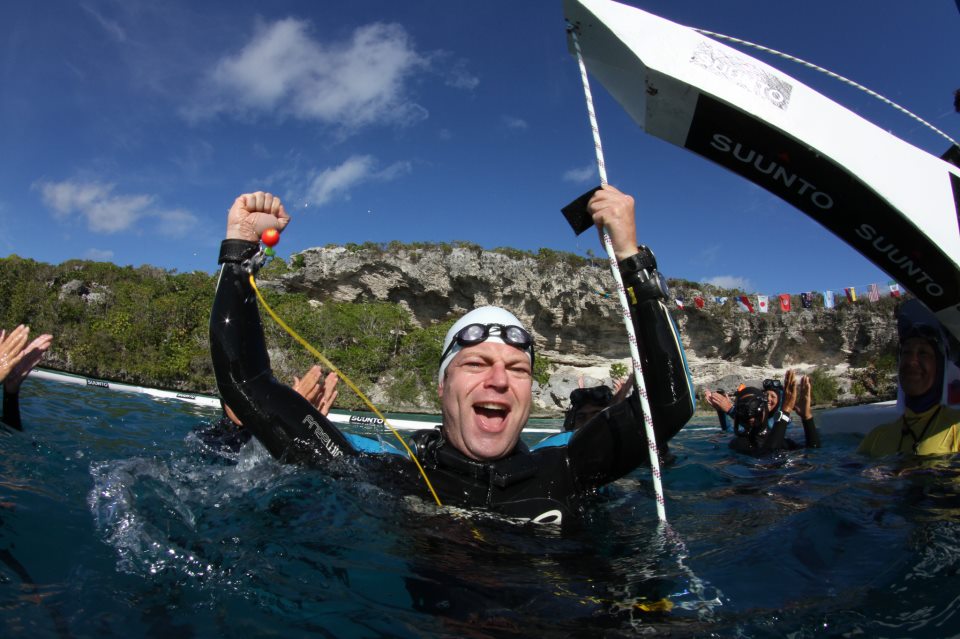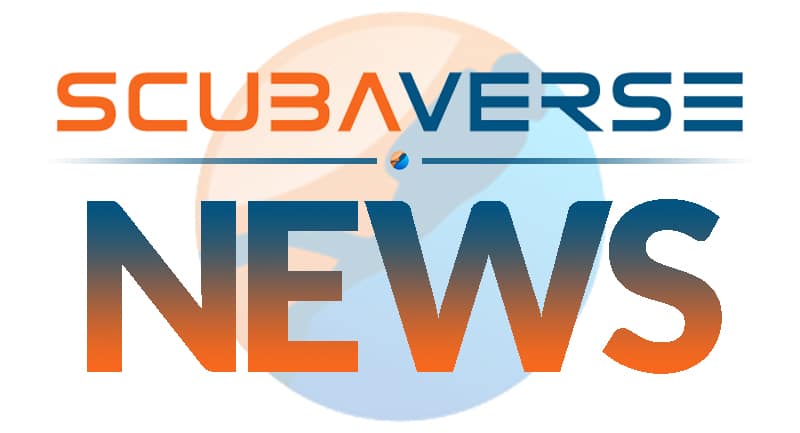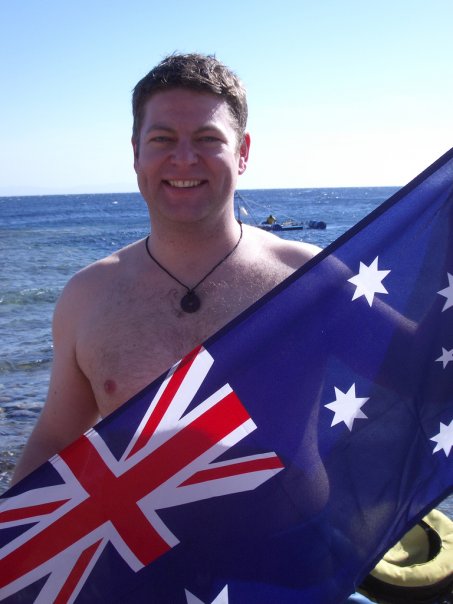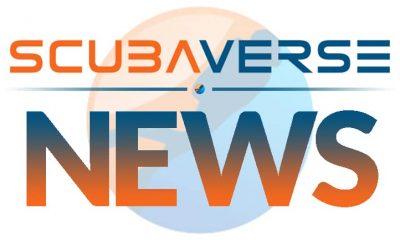News
Freediving Focus: Ben Noble

Australian Freediving champion Ben Noble talks about his latest Australian Record dives.
In June2010 I travelled to Greece to attend the 3rd Mediterranean Freediving World Cup 2010, held in the Messinian Bay near the coastal township of Kalamata. The World Cup, in its third year attracts some of the best freedivers from around the globe. The contest was held over 5 days of diving and included the three depth disciplines of Constant Weight (the freediver descends to depth and back using fins or a monofin), Constant Weight Without Fins (diving without the use of fins) and Free Immersion (diving without using fins but allowing the diver to pull on the rope), the winner having the highest score from their best dives in each discipline. In addition, the organisers had set up a freediving sled, a device used in the two other depth events of Variable Weight (using a sled to descend, then leaving it and swimming back up) and No Limits (using a sled to descend then activating a lift bag to bring the diver back up). These events are not offered in competition due to the logistical difficulties as well as the dangers of the deeper dives that they allow.
In Egypt two years earlier I had set Australian records in Variable Weight and No Limits at 72m and 80m respectively, and when I discovered that there would be sled facilities at the competition site I decided to see if I could extend these records a little more, with the vague notion of a 3 digit figure in the back of my head. With this in mind I started my training regime straight after New Year’s celebrations. I broke my training down into three main elements – general fitness training, breath hold training and depth training.
Since returning to Australia in 2008 my fitness had taken a back seat whilst I returned to the regime of getting a job and settling back into the Australian way of life of barbecues, beers and catching up with old mates. Before I knew it I had put on a significant amount of weight and had become somewhat of a couch potato. I sat down with my personal trainer, outlined my goals and put myself on a strict high protein, low carbohydrate, no alcohol eating plan. As my fitness returned I ramped up the intensity, and at my peak I was training at the gym around 10 times a week – sneaking off at lunch for a quick cardio session then another weight session in the evening and walking 5km home each night. By the time of the competition I had lost 20kg and had pretty good tolerance for lactic acid burn, essential for deep diving when you get excruciating lactic acid build-up in your legs.
During this time I was also training my ability to hold my breath, and also my ability to tolerate high levels of Carbon Dioxide, which trigger the body’s urge to breathe when holding your breath. One of the more bizarre exercises I included in a gym session (don’t try this at home!) was a 40 second breath hold on the seated bike whilst pedalling followed by a 20 second recovery and then repeated for an hour. I also included a pool session once a week doing various breath holds.
For my depth training it was a little hard to find good access to deep water where I live in Brisbane so once or twice a month I would fly to Cairns and dive in an old volcanic crater that was rumoured to be around 80m deep. Ideally I would have liked a lot more depth training but I knew that I had 7 days to train before the competition, and generally my depth training is more effective in the days leading up to a deep dive.
When I finally arrived in Greece my first day of diving was quite unsettled – new equipment, new safety team and my first deep dive in salt water in three years. After a couple of shallow warm up dives we set the rope to 70m – the purpose of this dive was not the depth but really to get used to the setup and to make sure everything felt fine both physically and mentally. The training dives were all Variable Weight dives, as training Variable also trains No Limits, killing two birds with one stone. My first mistake was to not wear a belt around my waist; as soon as I left the surface my wetsuit filled up with water and ballooned the whole way down. I also had equalisation problems past around 50m and had to use the brake on the sled a couple of times to stop before the pressure built up too much in my ears. The swim back to the surface felt great however so I knew my hours in the gym had paid off.
During the next 6 days my diaphragm became more flexible with each dive and I went from 70m to 80m, 83m and 90m. On the following day I looked at my dive gauge after what felt like a good dive only to see to my dismay that the gauge had malfunctioned and just had dashes across the screen. I grumbled something under my breath and a safety diver came over, looked at my gauge, smiled and said “you know these gauges don’t work past 100m. Well done!” I had made my target of 100m. Later that afternoon I announced an Australian Record attempt of a Variable Weight dive to 100m for the following day.
Perfect conditions greeted us in the bay the next morning and I got in the water for my usual warm ups. After these were completed I made my way over to the official rope and started my last 5 minutes of preparation. When I was ready, I took my last breath and released the brake on the sled. With 20kg of ballast, the sled moved quite fast and within a few seconds I felt the water temperature drop which is a signal that i’m around 30m already. Around this point I changed equalising methods to “mouthfill” – a technique moving air from the lungs to the mouth in order to be able to continue equalising a lot deeper. This works for some time but gradually it gets harder and harder to equalise, until I hear the beeping of my depth alarm telling me i’m nearly at the bottom. There was a noise as the sled hit the end of the rope and my descent suddenly stopped and the realisation that I was at 100m began to hit me. Exactly 1 minute has passed as I started my ascent, kicking hard off the bottom using my monofin, a Russian-made fin that looks a bit like a dolphin tail. The swim to the surface was long, a minute and a half in total and my legs started to fatigue about three quarters of the way up. Eventually I saw a safety diver meeting me at 30m which gave me a little mental push and the last few metres I stopped kicking completely and let my buoyancy carry me to the surface. On the surface I took 3 huge breaths of air and performed my surface protocol to the watching judges – taking my goggles and noseclip off, giving an OK sign and saying “I am ok” within 15 seconds of surfacing. There was a nervous wait as the judges determined that I was not about to black-out and I have not violated any rules, until finally they smiled and concluded the dive was successful. I was elated about the record, but I think I was even more elated about the fact that I could finally have a day off from diving the next day.
After my day off the competition started and I had two successful Constant Weight dives. The next day was supposed to be a rest day but I was feeling quite healthy so I decided to make an attempt on the No Limits Australian record. For No Limits, the sled is altered slightly in that a lift bag is attached and a tank added to inflate the bag. With my warm ups done, I went to the main rope and had a crash course in sled operation, did my breath up and released the brake. The first thing I noticed was that without my monofin (I was wearing standard fins) there was less drag and I was going a lot faster through the water. The trip down was good and my equalising felt a lot better than my previous dive, although the increasing pressure made it more difficult to equalise near the bottom – at 105m there is over 11 times the pressure which makes my 7 litre lungs compress to just over half a litre. As I hit the bottom I started to fill the lift bag which seemed to take forever to fill – what felt like a minute was actually around 20 seconds and I started to realise that I was suffering from Nitrogen Narcosis – the “rapture of the deep” that can make a diver feel euphoric and more than a little spaced out. Eventually the sled started to move and started my journey back to the surface. I was surprised at how fast the sled was travelling; at one point I looked up and my goggles were torn from my face and my wetsuit hood started to peel back. Somewhere around 50m I let go of the sled, I wanted to slow down at the end and enjoy the last part of the dive. Gradually I could see the surface approaching with the outline of the boat and a myriad of safety divers, in water judges, cameramen and some casual observers. As I approached, everyone cleared out of the way and I surfaced for my first breath of air in nearly 3 minutes. The judges judged, I waited and a minute later I had my Australian record dive of 105m and became the first Australian to have dived past 100m on a single breath of air.
With the pressure of the records now behind me, I enjoyed my 3 last dives of the competition in Free Immersion and Constant Weight No Fins and managed personal best depths in each dive. I placed 8th in the competition and since then have not had a day go by without daydreaming of diving in the amazing waters of the Mediterranean.
Now back in Australia, I am an accredited AIDA Freediving Instructor and I teach AIDA courses in and around Queensland in some of the most beautiful waters in the world. If you would like to do a freedive course please contact info@freedivedownunder.com
Blogs
Dive into the Full Moon: Experience Palau’s Spectacular Spawning Show

For a truly exceptional diving experience, Liquid Diving Adventures offers a Full Moon Spawning trip from May 20-30, 2025, aboard the Palau Siren liveaboard. This carefully timed journey coincides with the spectacular spawning events of red snappers, creating a breathtaking underwater display that divers won’t want to miss.

During the full moon, red snappers gather in large schools at specific spawning sites, where they release their eggs and sperm in a synchronized event that fills the water with vibrant colors. This incredible spectacle attracts various predators, including sharks and larger fish, which come to feed on the plentiful eggs. Divers have the unique opportunity to witness this dramatic interaction, showcasing the dynamic relationships within the marine ecosystem.

Liquid Diving Adventures curates this experience to provide divers with unparalleled insights into the behavior of red snappers during their spawning ritual. Expert guides share valuable information about the species, their habitat, and the significance of these events to the overall health of the reef ecosystem, enhancing the experience for all participants.

In addition to the thrilling spawning events, some itineraries also offer the chance for blackwater diving. This night-time adventure lets divers explore the ocean’s depths, encountering bioluminescent creatures and other fascinating marine life that thrive in the darkness.

About Palau Siren
The Palau Siren is a 40-meter motorsailor meticulously designed and constructed for divers. Built in Indonesia, this vessel is handcrafted from ironwood and teak to ensure durability and elegance. With a dedicated crew of 12, the ship caters to the needs of up to 16 divers.

Accommodations include eight air-conditioned cabins, each equipped with entertainment systems and ensuite bathrooms. The ship boasts an air-conditioned dining area and lounge that features a cocktail bar, sofas, a flat-screen TV, and a comprehensive entertainment system. To help divers unwind after a day of exploration, daily massage services are available.

Dining is a delightful experience on board, with a covered outdoor dining area where meals are served buffet-style, complemented by an upper-level sun deck furnished with chaise lounges. The covered dive deck is well-equipped with individual gear stations and storage lockers for each diver.

For convenience, all Siren charters provide tanks, weights, BCDs, regulators, wetsuits, masks, and fins at no additional cost, allowing divers to book their trip without the hassle of bringing personal gear. The main lounge features a professional-quality camera and video station for those looking to capture their underwater adventures.

The Palau Siren operates year-round dive trips to Palau, offering complimentary nitrox and supporting rebreathers, though it does not accommodate technical diving. Please note that rebreathers are not available for rent on board.
BOOK IN NOVEMBER AND SAVE $1200 USD!
|
|
News
Scubaverse Acquired by Multiversal Media: A New Era of Expansion into Outdoor Travel and Wildlife Markets

Scubaverse is thrilled to announce its acquisition by Multiversal Media, marking an exciting new chapter in the evolution of the company.
This strategic move aims to fuel further investment and expansion both within niche scuba sectors and into the broader wildlife and outdoor travel markets. The acquisition reflects Multiversal Media’s commitment to enhancing Scubaverse’s capabilities and offerings, ensuring a deeper insight into the diving market while also broadening the scope beyond diving. With increased resources and an expanded team, Scubaverse is poised to delve into diverse travel experiences and outdoor adventures, creating a comprehensive platform for adventure seekers and nature enthusiasts.
“Joining forces with Multiversal Media opens new doors for Scubaverse,” said Dave Alexander, the Founder of Scubaverse. “This partnership not only reinforces our dedication to the diving community, but also empowers us to explore innovative opportunities across the outdoor travel landscape. We are excited about what the future holds and look forward to delivering a richer, more varied experience for our audience.”
Together, Scubaverse and Multiversal Media will focus on integrating advanced insights and strategies to elevate the brand’s presence and offerings. As part of this transition, subscribers and followers can anticipate enhanced content, more extensive travel guides, and exciting collaborations that cater to both diving enthusiasts and outdoor adventurers alike.
About Scubaverse
Scubaverse is a leading media platform for divers from all over the globe, offering insights, news, and resources dedicated to the scuba community. With an unwavering passion for underwater exploration, Scubaverse continues to thrive as a hub for divers worldwide.
About Multiversal Media
Multiversal Media is a dynamic media company focused on creating expansive travel and wildlife content. Committed to showcasing the beauty of nature and the adventure of exploration, Multiversal Media is dedicated to connecting audiences with the outdoor world.
-

 News1 month ago
News1 month agoIconic SS United States to become the World’s Largest Artificial Reef
-

 Blogs3 months ago
Blogs3 months agoNovoScuba’s Game-Changing Approach for Dive Store Owners: WE PAY YOU!
-

 News2 months ago
News2 months agoBook Review – 52 Assignments: Underwater Photography
-

 Gear News2 months ago
Gear News2 months agoDYNAMICNORD – New German diving brand enters the British market
-

 News2 months ago
News2 months agoExploring Cenote El Pit: A Diver’s Dream
-

 Gear News2 months ago
Gear News2 months agoTry BARE drysuits (and maybe even win one!) this Friday with Sea & Sea at North West Dive Fest
-

 News3 months ago
News3 months agoComing Soon – 52 Assignments
-

 Marine Life & Conservation2 months ago
Marine Life & Conservation2 months agoBook Review: Coral Triangle Cameos

















